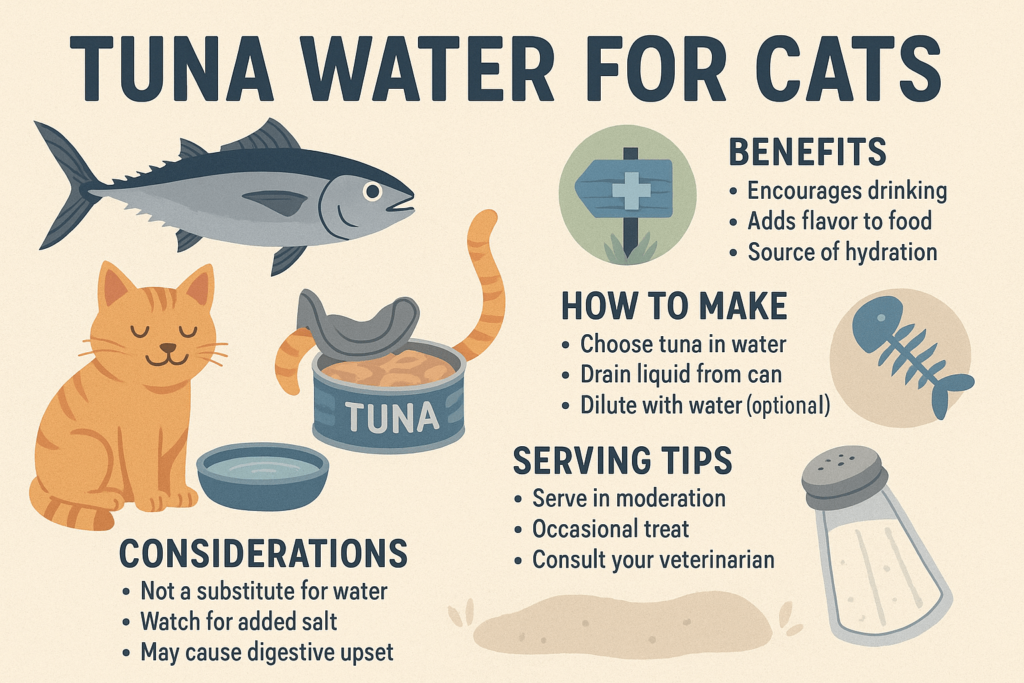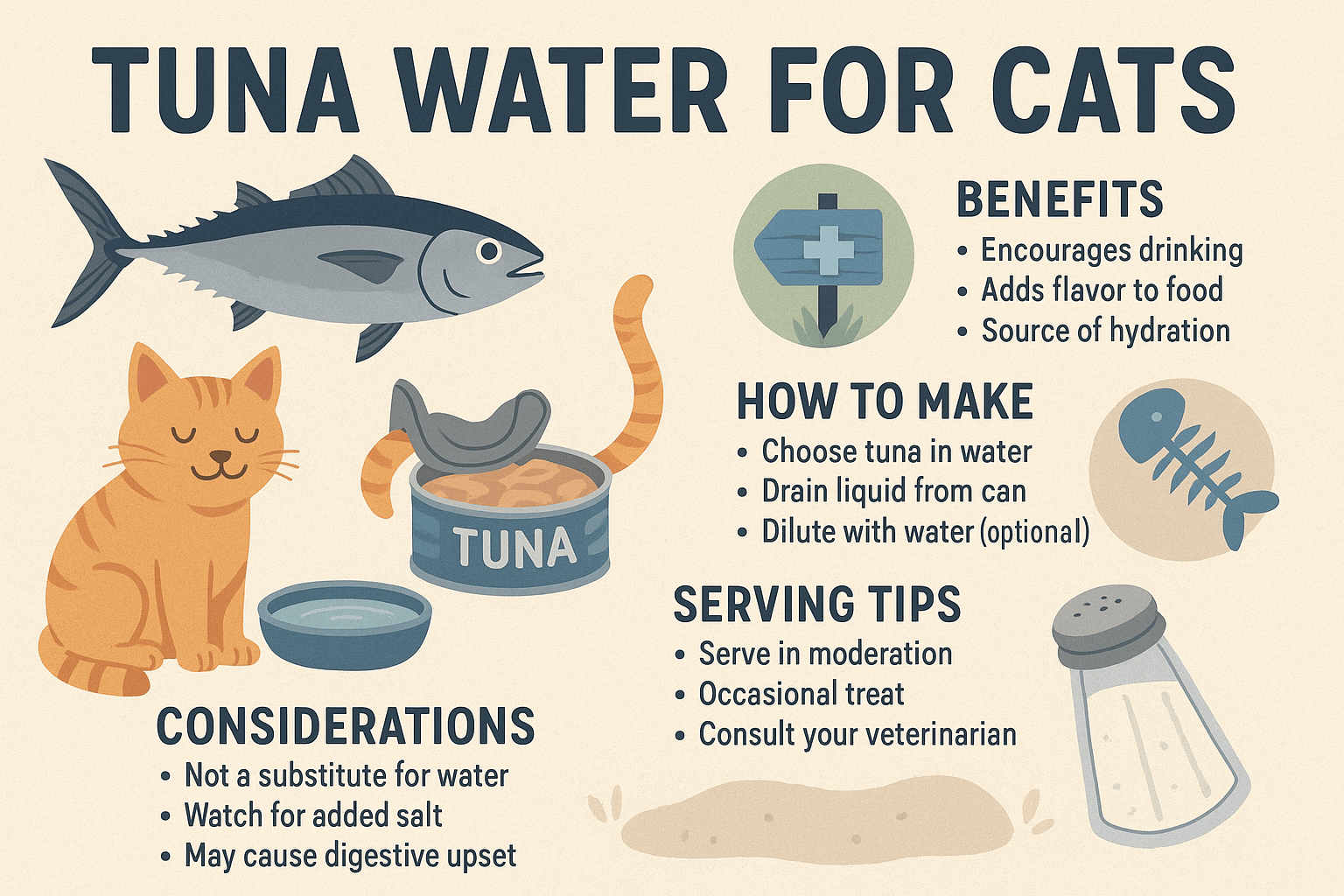Tuna Water for Cats: A Safe Treat or Hidden Risk?
Cats are notorious for their love of fish, and tuna often tops the list of their favorite flavors. Many cat owners wonder if offering tuna water—a simple byproduct of canned tuna—can be a safe and healthy treat for their feline friends. While it may seem harmless, there are important considerations to keep in mind before sharing this snack. Tuna water can provide hydration and a tasty reward, but it also carries potential risks if not used properly. In this blog post, we’ll explore the benefits, drawbacks, and best practices for incorporating tuna water into your cat’s diet, ensuring you make informed decisions about their health and happiness.
Expert Opinion: Dr. Sara Ochoa
“Tuna is low in carbs but high in protein. It also contains a lot of omega fatty acids. I will offer my cat a small bite of tuna on a very rare occasion. I am not a huge fan of fish, so we rarely have any fish in our house to share with him. Usually I offer my cat a small bite of chicken or a cat treat.”
Benefits of Tuna Water for Cats
Tuna water can offer several advantages when given in moderation, making it an appealing option for cat owners looking to add variety to their pet’s diet. Here are some key benefits to consider.
Encourages Hydration:
Cats often struggle to drink enough water, and tuna water’s strong smell can entice them to consume more fluids, promoting better hydration.Adds Flavor Without Calories:
Unlike high-calorie treats, tuna water provides a burst of flavor without significantly increasing your cat’s daily calorie intake.Rich in Protein-Derived Nutrients:
The water contains trace amounts of protein and nutrients from the tuna, which can complement your cat’s natural carnivorous diet.Aids in Medication Administration:
Mixing tuna water with medications can mask unpleasant tastes, making it easier to administer pills or liquid treatments.Boosts Appetite for Picky Eaters:
For cats with reduced appetites due to illness or age, tuna water can stimulate interest in food by enhancing its aroma.
While these benefits make tuna water an attractive choice, moderation is key to avoiding potential downsides.

Potential Risks of Feeding Tuna Water to Cats
Despite its appeal, tuna water isn’t without risks. Understanding these concerns helps ensure you use it responsibly and safeguard your cat’s health.
High Sodium Content:
Tuna water often contains elevated levels of sodium, which can lead to dehydration or kidney issues if consumed excessively.Lack of Balanced Nutrition:
Tuna water lacks essential nutrients like taurine, which cats need for heart and eye health. Relying on it as a primary treat can create nutritional gaps.Risk of Mercury Exposure:
Tuna itself may contain traces of mercury, and frequent consumption could pose long-term health risks for your cat.Addictive Behavior:
Some cats develop a preference for tuna water over their regular food, leading to picky eating habits that disrupt balanced nutrition.Allergic Reactions:
Although rare, some cats may experience allergic reactions to tuna or its byproducts, such as vomiting or diarrhea.
Awareness of these risks allows you to make smarter choices about how and when to include tuna water in your cat’s routine.
Check this guide 👉Can Cats Eat Vitamin D? Best 7 Expert Tips!
Check this guide 👉Can Cats Eat Soybean Oil? Best 7 Expert Tips!
Check this guide 👉Can Cats Eat Watercress? Best 7 Expert Tips!
Benefits of Tuna Water for Cats | Risks of Tuna Water for Cats |
|---|---|
Encourages hydration | High sodium content |
Low-calorie flavor enhancer | Lack of balanced nutrition |
Stimulates appetite | Potential mercury exposure |
Helps with medication | Risk of addictive behavior |
Adds variety to meals | Possible allergic reactions |
How to Safely Serve Tuna Water to Your Cat
If you decide to give your cat tuna water, following these guidelines ensures their safety and enjoyment. Proper preparation minimizes risks while maximizing benefits.
Choose Low-Sodium Tuna:
Opt for tuna packed in water with no added salt to reduce sodium intake and protect your cat’s kidneys.Dilute the Tuna Water:
Mix tuna water with plain water to further lower sodium levels and stretch its hydrating properties.Use Sparingly as a Treat:
Limit tuna water to occasional use rather than a daily staple to prevent overconsumption and nutritional imbalances.Avoid Tuna in Oil:
Always select tuna packed in water instead of oil, as oily residues can upset your cat’s digestive system.Monitor for Adverse Reactions:
Watch for signs of gastrointestinal distress, such as vomiting or diarrhea, after introducing tuna water.
By adhering to these tips, you can safely incorporate tuna water into your cat’s diet without compromising their well-being.
Alternatives to Tuna Water for Hydration and Flavor
If you’re hesitant about using tuna water, there are other ways to encourage hydration and add excitement to your cat’s meals. These alternatives provide similar benefits without the associated risks.
Bone Broth (Unseasoned):
Plain, unsalted bone broth is a nutritious and hydrating option that appeals to many cats.Wet Cat Food:
High-quality wet food contains moisture-rich ingredients that naturally boost hydration.Water Fountains:
Cats are often drawn to running water, so investing in a pet water fountain can increase their water intake.Herbal Infusions (Cat-Safe):
Adding diluted catnip tea or chamomile water to their bowl can enhance flavor without harmful additives.Homemade Fish Broth:
Preparing a low-sodium broth from cooked fish (like salmon) offers a safer alternative to store-bought tuna water.
Exploring these options allows you to cater to your cat’s preferences while prioritizing their health.
Signs Your Cat Enjoys Tuna Water
Not all cats react the same way to new foods, including tuna water. Observing your cat’s behavior can help determine whether they enjoy it and tolerate it well.
Increased Lapping at the Bowl:
If your cat eagerly drinks from their bowl after adding tuna water, it’s a clear sign they find it appealing.Heightened Interest in Mealtime:
Cats who typically ignore their food may show renewed enthusiasm when tuna water is involved.Seeking Out the Smell:
Your cat might sniff around the kitchen or follow you when they detect the scent of tuna water.No Signs of Digestive Upset:
A lack of vomiting, diarrhea, or other adverse reactions indicates tolerance to the treat.Repeated Requests for More:
Cats may meow or paw at their bowl if they want another serving, signaling their approval.
These behaviors confirm that your cat enjoys tuna water, but remember to monitor portion sizes to prevent overindulgence.
Tips for Transitioning Away from Tuna Water
If you’ve been using tuna water regularly and want to reduce dependency, here are some strategies to ease the transition.
Gradually Decrease Portions:
Slowly reduce the amount of tuna water mixed with their food to minimize resistance.Introduce New Flavors:
Experiment with other enticing flavors, such as chicken broth or fish-based wet food, to diversify their palate.Mix with Regular Food:
Blend small amounts of tuna water with their usual meals to maintain familiarity while cutting back.Reward with Play Instead of Treats:
Shift focus away from food rewards by engaging your cat in interactive play sessions.Create a Consistent Routine:
Establish predictable feeding times to help your cat adjust to changes in their diet.
With patience and consistency, transitioning away from tuna water can go smoothly while keeping your cat content.
Creative Ways to Use Tuna Water Beyond Meals
Beyond simply mixing tuna water with food, there are fun and practical ways to incorporate it into your cat’s daily life. These creative uses maximize its appeal while maintaining moderation.
Freeze into Ice Cubes:
Freeze diluted tuna water into ice cubes for a refreshing summer treat that lasts longer.Soak Dry Kibble:
Pour a small amount of tuna water over dry kibble to soften it and enhance flavor for older cats.Use as a Toy Reward:
Dip interactive toys, like puzzle feeders, in tuna water to motivate your cat during playtime.Incorporate into DIY Treats:
Combine tuna water with gelatin or cat-safe ingredients to create homemade frozen snacks.Enhance Bland Diets:
Add a splash of tuna water to bland diets prescribed by vets to improve palatability during recovery periods.
These innovative ideas allow you to get creative with tuna water while ensuring it remains a special, occasional treat.
Frequently Asked Questions About Tuna Water for Cats
Can I give my cat tuna water every day?
No, tuna water should only be given occasionally to avoid excessive sodium intake and nutritional imbalances.
Is tuna water better than tuna chunks?
Yes, tuna water has fewer calories and fat compared to solid tuna but still poses risks if overused.
What type of tuna is safest for cats?
Skipjack tuna packed in water with no added salt is the safest choice for occasional use.
Can kittens have tuna water?
It’s best to avoid giving tuna water to kittens, as their developing bodies require precise nutrition.
How much tuna water is safe per serving?
A teaspoon or two diluted with water is sufficient for most cats, depending on their size and dietary needs.
Making Smart Choices for Your Cat’s Diet
Tuna water can be a delightful and hydrating treat for cats when offered responsibly, but it’s crucial to balance indulgence with caution. By understanding the benefits, risks, and alternatives, you can ensure your cat enjoys occasional treats without jeopardizing their health. Whether you choose tuna water or explore other options, always prioritize hydration, nutrition, and moderation in your cat’s diet. With thoughtful care and attention, you can keep your feline friend happy, healthy, and satisfied—one sip at a time.
Canned Pumpkin for Cat Diarrhea: Best 7 Expert Tips! Natural remedy to firm stools, soothe upset bellies, and support gut health safely.
Can a Cat Give You Scabies? Best 7 Expert Tips! Discover the truth about feline mites, human skin risks, and how to protect yourself—without panic.
Cat Flea vs Human Flea: Best 7 Expert Tips! Discover the truth about bites, species, and how to eliminate infestations for good.
Weird Cat Behaviors: Best 7 Expert Tips! Discover why cats do strange things—and how to understand, not punish, their instincts for a happier home.





